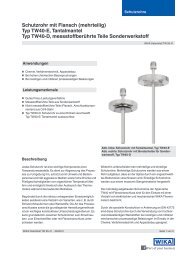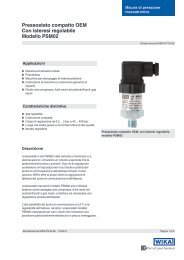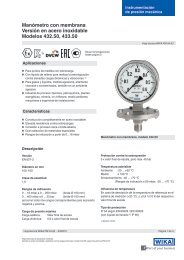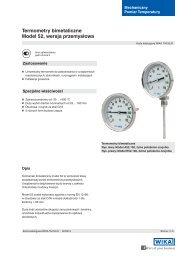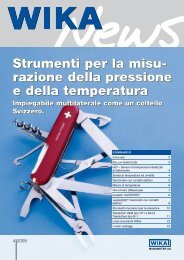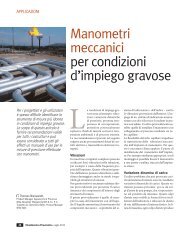2015 WIKA USA
WIKA Price List
WIKA Price List
You also want an ePaper? Increase the reach of your titles
YUMPU automatically turns print PDFs into web optimized ePapers that Google loves.
SELECTING A PRESSURE GAUGE<br />
MSRP List > Selecting a Pressure Gauge<br />
Selecting a Pressure Gauge<br />
When selecting a pressure gauge, it is important to consider the following factors to ensure safety and accuracy:<br />
1. Pressure fluid composition<br />
2. Pressure fluid temperature<br />
3. Ambient conditions<br />
4. Pressure range<br />
5. Conditions affecting wear of the system<br />
6. Method of mounting<br />
7. Required accuracy<br />
1. Pressure fluid composition<br />
Since the sensing element of a pressure gauge may be exposed directly to the measured medium, consider the<br />
characteristics of this medium. It may be corrosive, it may solidify at various temperatures or it may contain<br />
solids that will leave deposits inside the sensing element. For pressure fluids that will not solidify under normal<br />
conditions or leave deposits, a Bourdon tube gauge is acceptable. Otherwise a Sealgauge or diaphragm seal<br />
should be used. A chemical compatibility chart follows this section to aid in the selection of the proper sensing<br />
element material.<br />
2. Pressure fluid temperature<br />
Steam and other hot media may raise the temperature of the gauge components above safe working limits of the<br />
sealed joints. In these cases it is recommended that a siphon, cooling tower or diaphragm seal be used in<br />
conjunction with the pressure gauge.<br />
3. Ambient conditions<br />
The normal ambient temperature range for <strong>WIKA</strong> pressure gauges is -40 o F to +140 o F (-40 o C to +60 o C) for dry or<br />
silicone-filled gauges and -4 o F to +140 o F (-20 o C to +60 o C) for glycerine-filled gauges. The error caused by<br />
temperature changes is +0.3% or -0.3% per 18 o F rise or fall, respectively. The reference temperature is 70 o F<br />
(20 o C). The correction is for the temperature of the gauge and not the temperature of the measured medium.<br />
Remote gauge mounting using a diaphragm seal and capillary line is one alternative for applications involving<br />
extreme ambient temperature.<br />
Moisture and weather effects must also be considered. Liquid-filled gauges prevent condensation build up.<br />
For outdoor use, stainless steel, brass or plastic cased gauges are recommended.<br />
4. Pressure range<br />
A gauge range of twice the working pressure is generally selected. The working pressure in all cases should be<br />
limited to 75% of the gauge range. Where alternating pressure and pulsation are encountered, working pressure<br />
should be limited to 2/3 of the gauge range.<br />
5. Conditions affecting wear of the system<br />
In applications involving severe pressure fluctuation or pulsation, the use of restrictors and/or snubbers is<br />
recommended. In addition, liquid-filled gauges increase the service life of gauges in these conditions. <strong>WIKA</strong><br />
liquid-filled gauges are generally filled with glycerine. Silicone for larger temperature extremes and Halocarbon ®<br />
for use with oxidizing agents such as chlorine, oxygen and hydrogen peroxide are also available.<br />
6. Method of mounting<br />
Radial (LM) and back (CBM or LBM) connections are available for most <strong>WIKA</strong> gauges. <strong>WIKA</strong> stocks gauges with<br />
standard NPT threaded connections. Other types such as metric threads, straight threads, hose barbs and<br />
special fittings are available as a special order.<br />
Pressure gauges should be mounted in the upright position. For applications where the gauge is mounted side<br />
ways, horizontally or upside down, contact <strong>WIKA</strong> Customer Service for gauge type compatibility.<br />
7. Required accuracy<br />
<strong>WIKA</strong> stocks gauges with accuracies from ± 3/2/3% to ±0.1% of span (ASME Grade B to Grade 4A).<br />
To ensure safe and accurate gauge selection, you must take all of the above factors into consideration. When in doubt,<br />
please do not hesitate to contact your local stocking distributor or <strong>WIKA</strong> Customer Service for assistance!<br />
1-888-<strong>WIKA</strong>-<strong>USA</strong><br />
3




